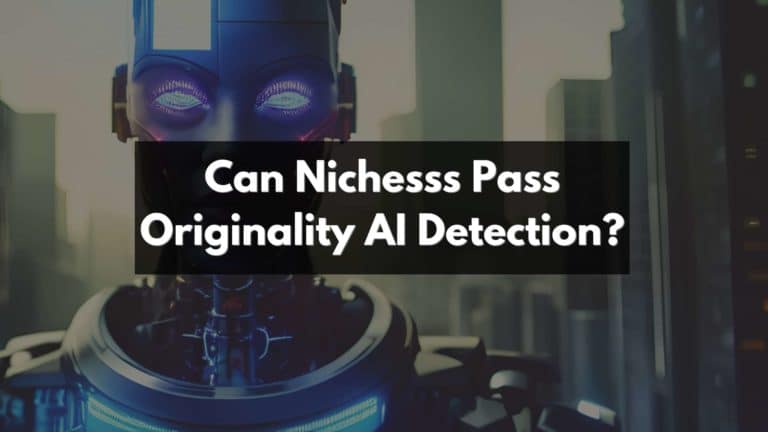Can TextCortex Pass Turnitin Detection?
Are you wondering if TextCortex, an AI-powered writing tool, can bypass the stringent detection system of Turnitin? I’ve been in your shoes too and found that this is a common concern amongst users.
After extensive research and testing, I discovered some intriguing information about the capabilities of both TextCortex and Turnitin’s AI detection. Join me as we delve into whether these two high-tech tools can outsmart each other!
Key Takeaways
- Turnitin’s AI detection system is designed to identify various types of content, including plagiarism and content generated by AI writing tools like TextCortex.
- Factors such as paper length, word choice and language, plagiarism patterns, grammar and spelling accuracy, originality of ideas, and updates to Turnitin’s algorithm can influence the detection of AI-generated content.
- Strategies to avoid detection include carefully paraphrasing content, using unique language and style, checking for spelling and grammar errors, controlling word count, and adjusting text case and formatting.
- Using AI writing tools poses risks to academic integrity and raises ethical concerns. The potential consequences of getting caught include academic penalties and damage to one’s reputation. It is important to consider these factors before using such tools.
Understanding Turnitin AI Detection
Turnitin AI Detection works by analyzing the content submitted to its system and comparing it against a vast database of academic sources, online content, and student submissions.
How Turnitin AI Detection works
Turnitin employs a sophisticated AI algorithm designed to detect plagiarism in academic work. This algorithm scans each submitted paper, compares it with billions of internet pages, student papers, and books stored in its vast repository.
Instead of just analyzing the text for copied words or phrases, it analyzes papery and word length to flag any suspicious content. The program generates an originality report showing areas that align too closely with other texts that are already published wherein the similarity index is calculated based on matching strings of words using proprietary techniques and algorithms.
Turnitin’s ChatGPT detector identifies content generated by AI like TextCortex by constantly updating its algorithms for enhanced detection accuracy which was evidenced when five high school students tested this feature successfully.
Therefore, it isn’t merely a spell checker but more than a tool ensuring academic integrity by providing crucial insights into every piece of written work’s originality.
Types of content that can be detected
Turnitin AI Detection has the capability to detect various types of content. It can identify plagiarized passages, copied text, and even content generated by AI writing tools like TextCortex. Additionally, Turnitin can flag cases of paraphrasing where the original source is not properly cited. The algorithm analyzes word choice, sentence structure, and other linguistic features to determine if the content is unique or if it matches existing sources in its extensive database. With its advanced detection methods, Turnitin aims to maintain academic integrity and ensure that all submitted work is original and trustworthy.
Limitations of Turnitin AI Detection
Turnitin’s AI detection system, while effective in catching instances of plagiarism, does have its limitations. The algorithm primarily focuses on paper and word length to flag potentially suspicious content.
However, it may not be able to detect all instances of plagiarism, especially when it comes to text generated by AI tools like TextCortex. Turnitin’s algorithms are continuously updated to improve their plagiarism detection capabilities, but they still might miss unique or well-crafted content produced by AI writing programs.
It is important for users to understand that while Turnitin is a widely used anti-plagiarism tool, it has certain constraints when it comes to detecting AI-generated content accurately.
Can TextCortex Pass Turnitin Detection?
TextCortex, an advanced AI writing tool, has the capability to generate unique and trustworthy content that can often bypass Turnitin’s AI detection.
Overview of TextCortex AI writing tool
TextCortex is an advanced AI writing tool that offers a range of powerful features for content creation. With TextCortex, you can generate unique, trustworthy, and captivating content to meet your specific needs.
It provides various text tools like spell checker, word count, text case conversion, and paraphrasing assistance. While Turnitin’s AI detection is constantly evolving to catch instances of plagiarism, TextCortex aims to create authentic content that can pass these detection systems.
Factors that influence detection
Several factors can influence the detection of AI-generated content by Turnitin’s algorithm, including:
- Paper length: The length of the paper can affect the likelihood of detection. Longer papers may have more opportunities for plagiarism, increasing the chances of being flagged.
- Word choice and language: Unusual or sophisticated vocabulary, complex sentence structures, or inconsistent writing styles can raise suspicion and increase the chances of detection.
- Plagiarism patterns: Turnitin’s algorithm is designed to recognize common plagiarism patterns and similarities in sentence structure and wording. If an AI writing tool generates content that matches these patterns, it may be more likely to be detected.
- Grammar and spelling accuracy: Turnitin’s software includes spell-checking features that can identify errors or inconsistencies in grammar and spelling. Content generated by AI may need to meet higher standards of accuracy to avoid detection.
- Originality of ideas: While Turnitin primarily focuses on text similarity, it also evaluates the originality of ideas presented in the content. If an AI-generated paper lacks unique insights or presents common knowledge without proper citation, it may still be flagged for potential plagiarism.
- Updates to Turnitin’s algorithm: Turnitin regularly updates its algorithms to improve plagiarism detection capabilities. As a result, AI-generated content that may have previously gone undetected could become more vulnerable to detection with each update.
Strategies to avoid detection
To avoid detection by Turnitin AI, I follow a few strategies:
- Carefully paraphrase content: I ensure that the text generated by TextCortex is not identical to the original source. Paraphrasing helps to maintain the meaning while using different words and sentence structures.
- Use unique language and style: By incorporating my own writing style and vocabulary, I make the content more personalized and less likely to match existing sources in Turnitin’s database.
- Check for spelling and grammar errors: I thoroughly proofread the generated text using TextCortex’s spell checker and correct any mistakes. This not only improves the quality of the content but also reduces the chances of detection.
- Control word count: Turnitin’s algorithm looks for similarities in paper length, so I make sure that the word count of my AI-generated content aligns with the requirements set by my instructor or institution.
- Adjust text case and formatting: TextCortex allows me to convert text to uppercase, lowercase, or title case. By modifying these elements, I create a visually distinct piece that is less likely to be flagged as plagiarized.
Risks and Consequences of Using AI Writing
Using AI writing tools like TextCortex poses risks to academic integrity and raises ethical concerns. The potential consequences of getting caught can be severe. Read on to understand why it’s important to consider these factors before using such tools.
Academic integrity concerns
Maintaining academic integrity is of utmost importance when using AI writing tools like TextCortex. Plagiarism detection software, such as Turnitin, can identify any instances of copied content and raise concerns about the authenticity and trustworthiness of the work.
It is crucial to ensure that any content generated with AI assistance is properly cited and attributed to avoid potential consequences such as academic penalties or damage to one’s reputation.
The responsibility lies with the user to use these tools ethically and create original, captivating content while respecting academic integrity guidelines.
Ethical considerations
Ethical considerations should be a top priority when using an AI writing tool like TextCortex to pass Turnitin’s detection system. It is important to consider the impact of using AI-generated content on academic integrity and the ethical implications of submitting work that may not be entirely original.
Students and writers should carefully weigh the risks and potential consequences of relying on AI tools for creating their content. This includes understanding the importance of plagiarism-free work, maintaining honesty, and upholding the principles of academic integrity in all their endeavors.
Potential consequences of getting caught
If you get caught using AI-generated content that bypasses Turnitin’s detection, there could be serious consequences. Academic integrity concerns come into play, as universities and educational institutions prioritize original work and penalize plagiarism.
It is not just an ethical issue but also a legal one, with potential disciplinary actions ranging from failing grades to academic probation or even expulsion. Being flagged for using AI-assisted writing can damage your reputation and credibility as a student or professional writer.
Don’t risk the negative outcomes; it’s important to create unique, trustworthy content that captivates readers while maintaining academic integrity.
Conclusion
In conclusion, while Turnitin’s AI detection system is continuously improving, it may still be able to identify content generated by TextCortex. The risks and consequences of using AI writing tools like TextCortex include academic integrity concerns and potential penalties if caught plagiarizing.
It is crucial for users to understand the limitations and ethical considerations involved when using such tools to ensure trustworthy and original content creation in academic settings.
FAQs
1. Can TextCortex pass Turnitin detection?
TextCortex is a powerful AI language model that can generate high-quality content, but it is not immune to Turnitin detection. Similar to any other text generation tool, the output generated by TextCortex may be flagged by plagiarism detection software like Turnitin.
2. How can I ensure my content passes Turnitin detection?
To ensure your content passes Turnitin detection, it’s important to properly cite and reference any sources used in your writing. Additionally, you should avoid copying and pasting directly from existing documents or websites and strive to write original and unique content.
3. Is using TextCortex considered plagiarism?
Using TextCortex itself is not considered plagiarism as long as you properly attribute any generated content that is used in your work. However, if you submit the generated content without proper citation or claiming it as your own original work, it could be seen as plagiarism.
4. Can I rely solely on TextCortex for creating academic papers?
While TextCortex can provide valuable insights and assist with generating ideas for academic papers, relying solely on an AI language model like TextCortex may not be advisable for creating entire academic papers. It’s crucial to conduct thorough research, critically analyze information from credible sources, and apply personal knowledge and expertise when crafting academic papers.






